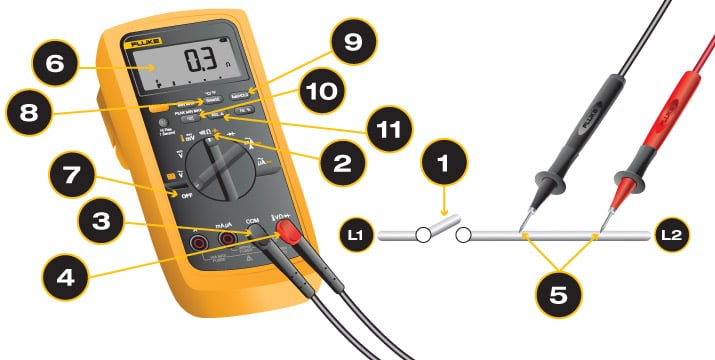Resistance is measured using analog or digital multimeters. These tools also measure current, voltage, and more for various applications. Why measure resistance? To determine the condition of a circuit or component. The higher the resistance, the lower the current flow, and vice versa.
In general, the resistance of components used to control circuits (such as switches and relay contacts) starts out very low and increases over time due to factors such as wear and dirt. Loads such as motors and solenoids decrease in resistance over time due to insulation breakdown and moisture.

To measure resistance:
1. Turn power to circuit OFF.
- If a circuit includes a capacitor, discharge the capacitor before taking any resistance reading.
- The display should show OLΩ because, in Resistance mode, even before test leads are connected to a component, a digital multimeter automatically begins taking a resistance measurement.
- The MΩ symbol may appear in the display because the resistance of open (unattached) test leads is very high.
- When the leads are connected to a component, a digital multimeter automatically uses the Autorange mode to adjust to the best range.
- Pressing the Range button allows a technician to manually set the range.
- Best results will be achieved if the component to be tested is removed from the circuit. If the component is left in the circuit, the readings could be affected by other components in parallel with the component to be tested.

3. First insert the black test lead into the COM jack.
4. Then insert the red lead into the VΩ jack.
- When finished, remove the leads in reverse order: red first, then black.
- Make sure that contact between the test leads and circuit is good.
Tip: For very low-resistance measurements, use the relative mode (REL; see point 11). It may also be referred to as zero or Delta (Δ) mode. It automatically subtracts test lead resistance—typically 0.2 Ω to 0.5 Ω. Ideally, if test leads touch (are shorted together), the display should show 0 Ω.
Other factors that can affect resistance readings: Foreign substances (dirt, solder flux, oil), body contact with the metal ends of the test leads, or parallel circuit paths. The human body becomes a parallel resistance path, lowering total circuit resistance. Thus, avoid touching metal parts of test leads to avoid errors.
6. Read the measurement on the display.
7. When finished, turn the multimeter OFF to prevent battery drain.
Advanced digital multimeter options
8. Press the RANGE button to select a specific fixed measurement range.
- Be sure to note the annunciator (such as K or M) after the measurement in the display.
10. Press the MIN/MAX button to capture the lowest and highest measurement.
- The multimeter beeps each time a new reading is recorded.
- Measurements above and below the reference value are displayed.
Resistance Measurement Analysis
The significance of a resistance reading depends on the component being tested. In general, resistance of any one component varies over time and from component to component. Slight resistance changes are usually not critical but may indicate a pattern that should be noted. For example, as the resistance of a heating element rises, the current passing through the element decreases, and vice versa. See diagram below.

When working on a circuit board, it may be necessary to lift one of the leads of the resistor from the board to measure the correct resistance of the resistor. The resistance measurement displayed by a digital multimeter is the total resistance through all possible paths between the test lead probes. Caution is required when measuring resistance across a component that is part of a circuit.
The resistance of all components connected in parallel with a component being tested affects the resistance reading, usually lowering it. Always check the circuit schematic for parallel paths.
How Do You Measure Resistance with a Multimeter? The Quick Checklist.
- Turn circuit power off.
- Turn multimeter dial to Ohms or Resistance.
- Insert black test lead into the COM jack.
- THEN insert the red lead into the VΩ jack.
- Connect test leads across the component beign tested.
- Read measurement on display.